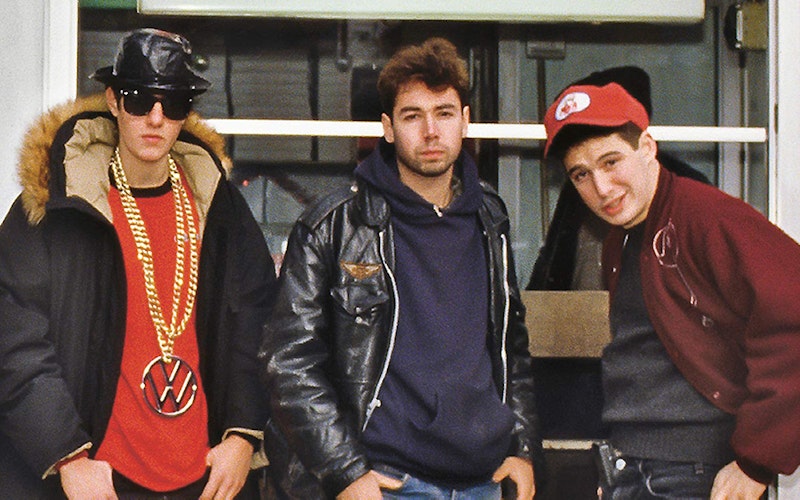
Culture At Large
The Life-Giving Friendship of Beastie Boys Book
The Beastie Boys will never be confused for the Inklings—perhaps history’s most famous book club, counting C.S. Lewis and J.R.R. Tolkien among its members.
The two groups, after all, signify very different cultures. Irreverent hip-hop icons, Beastie Boys were shaped by the glorious grit of 1970s and ’80s New York City. Marked by a quieter, more august wisdom, the Inklings represented some of 20th-century Britain’s sharpest literary minds. Yet, in their own distinct ways, each cohort offers a kindred answer to the question: “How did you become friends?”
Beastie Boys Book, released late last year, is a predictably unorthodox memoir written by the group’s two surviving members, Adam Horovitz and Michael Diamond. (Third band member Adam Yauch died of cancer in 2012.) The book offers many joys: the stories behind essential Beasties tracks; a collection of mixtapes and minutiae; and, most importantly, a 500-plus-page meditation on the nature and necessity of friendship.
In his indispensable text The Four Loves, C.S. Lewis describes the spark of friendship: “Friendship ... is born at the moment when one man says to another, ‘What! You too? I thought that no one but myself ...’” In both its style and substance, Beastie Boys Book houses that same spark, chronicling how Diamond, Horovitz, and Yauch fanned it into flame within their partnership. The book’s very first sentence, penned by Horovitz, reads: “We all have different types of friends, right?” He continues, recalling Yauch’s magnetism to an audience that only knew him through records and music videos. Perhaps the great through line of Beastie Boys Book is the way in which Yauch recognized like souls and inspired them to enjoy those “You too?” moments.
Beastie Boys met progressively through the NYC punk scene, Diamond and Yauch encountering each other first. “The thing about being the punk-rock kid at school was that you’d have no friends,” Diamond writes. “You looked like a weirdo with ill-fitting, torn-up and stenciled button-down shirts from the Goodwill store and a safety pin as an earring, and you would get laughed at.”
In Yauch, Diamond didn’t just see a look-alike. He found a friend who inspired others to throw away any cares about what polite society thought of them. “Soon we evolved into a bigger clique of like-minded outcasts,” Diamond writes.
With the first iteration of Beastie Boys intact, Diamond and Yauch met Horovitz through the same tight-knit scene. The trio bonded over bands such as Bad Brains, Black Flag, and The Clash, along with a common rejection of convention. Music, clothes, and sports mattered to these fast friends, but not purely for the sake of aesthetics. What you liked articulated something about what you held dear, about the kind of person you were and hoped to become. Through their own transformation from minor-league punks to hip-hop heads, the Beasties’ unique drive and desires held their relationship together.
Beastie Boys Book is a 500-plus-page meditation on the nature and necessity of friendship.
“For me, the reason why Beastie Boys stayed together for so long and had so much fun being a band is because Yauch + Mike are the family members I wanna see,” Horovitz writes. “They’re my two other brothers I love, and can depend on. ... And all three of us in the end were the friends that inspired one another to go big.”
Beastie Boys Book paints the trio as misfit magnets. As Diamond and Horovitz swap chapters—and often comment on the other’s passages—they tell stories of folding eccentric record-store owners, alligator-wrestling bus drivers, “white-collar hippies,” and frighteningly unreliable percussionists into their ragtag world. Anyone who exclaimed “You too?” could hang with the Beastie Boys—at least for a time.
The artistic vision for Beastie Boys Book reinforces the group’s open-arms approach to camaraderie. Diamond and Horovitz cede precious chapters to the likes of Amy Poehler, Colson Whitehead, and Spike Jonze, who exclaim “You too?” in their own words. A bounty of candid photographs depicts the band as three brothers who were in on the same jokes, and might just know a few of the universe’s secrets. The Beastie Boys pulled other people in, but the three of them clearly mattered most.
The creators of the Porterbrook Network, a distance-learning theological collective and curriculum, take the phrase “You too?” beyond Beastie Boys and even a step past Lewis. They suggest the gospel is the ultimate “You too?” Those who have been surprised by grace stick together, building Christ’s church, even if they would have little to do with one another in their previous life.
This quietly radical suggestion finds its fulfillment in the life of Jesus, the ultimate misfit magnet. Though the Bible says there was nothing immediately charismatic about him, at least not by society’s standards, he brought together people who had nothing in common but him.
Jesus scatters whoever he gathers, sending them into a world in need of the common ground of the gospel. We carry the message of an unexpected community bound by mercy. If Jesus prompts our “You too?,” we can be confident that we’re tighter than any crew of MCs and have more to talk about than even the Inklings did.
Topics: Culture At Large